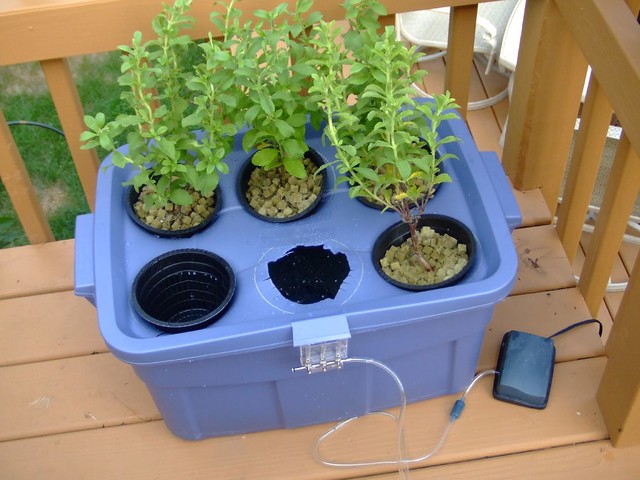 |
| Photo by J Wynia |
Hydroponic gardening eliminates soil-borne pests and diseases and maximizes water and nutrient uptake by the plant. Incredible yields can be achieved in a relatively small space with hydroponic systems. There are many types of hydroponic systems available for home and commercial use.
These systems include the Europonic Rockwool System, the Ebb and Flow System, Aeroponic Systems, Continuous Drip Systems, and Rock wool Based Systems. Hydroponic systems come in all shapes and sizes and can be adapted for nearly any budget.
Nutrient Film Technique, or NFT, is another popular system. The plants are held in troughs with nutrient solution constantly trickling over the roots. A reservoir with a pump that is submersible re-circulates the nutrient solution continually, pumping the solution to the top of the troughs to trickle back through the system. Larger Nutrient Film Technique systems are used commercially, both abroad and in the United States. When choosing a Nutrient Film Technique system, care must be taken to choose the correct trough size.
Large commercial systems use wider troughs with greater flow capacity. Aeroponics is a system in which the plant’s roots are suspended in the air. They are excellent for growing herbs and leafy vegetables. The plants are held in web pots with neoprene inserts to support the plant. Different hold configurations in the top cover provide the proper spacing. Aeroponic systems are also great propagators. The seedlings can be germinated in Rockwool then transferred directly to the web pots.
The Europonic System is modelled after commercial systems that are used in Europe. A basic system has three trays and holds eight plants each. The system may also be expanded to five trays if desired. A nutrient solution is pumped from a thirty-gallon reservoir to individual emitters at each plant. The solution trickles through the rock wool, over the roots, and back to the reservoir where it is re-circulated on a constant basis. Rock wool, or mineral wool, is the most popular and highly used hydroponic medium. It is made from spun material fibres and has a high water and air holding capacity.
The Europonic System uses rock wool slabs with two slabs fitting into each tray. Rock wool is easily able to support a relatively extensive root system so the Europonic System is ideal for vine crops such as tomatoes, cucumber, and peppers, plus large flowering plants.
In a continuous drip system, a single pot is used with a two-gallon reservoir underneath. The system acts like a percolator as air is pumped down a vertical shaft, creating pressure, and nutrient solution is forced up another tube. A drip ring constantly irrigates the substrate, and the nutrient solution drains back into the reservoir. This type of system is easy to use, inexpensive, and great for individual experimentation. However, it is impractical for most commercial applications. Ebb and flow systems are also popular in hydroponics. They are good for crops such as lettuce, pepper plants, miniature tomatoes, and potted flowers.
As the water evaporates between flooding, the salts are left behind as a residue and may rise to toxic levels. It is best to flush the system with pure water periodically to take away any toxic salt buildup.






